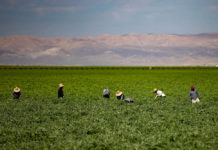Body oppression is defined as being treated less well because of something about your body (size, color, age, gender expression, disability).
One of the common ways body oppression manifests is through body size. This was the topic most addressed by co-authors Debbie Notkin and Lucy Tobin Edison, whose book “Women en Large” depicts beautiful black and white photos of fat women. They spoke on Monday, Nov. 16, at the Peace and Justice Center in Santa Rosa, sponsored by Occupy Sonoma County.
What is beauty is relative. In earlier times and in other cultures fat was seen as not only beautiful, but as a difficult-to-attain sign of wealth. Today beauty is seen as young, thin, blue-eyed, blond and energetic. This is portrayed everywhere in the media.
Children are continually exposed to this portrayal in television commercials and programs, magazines, and billboards. By puberty, adolescent girls, who are the most vulnerable, are deluged with the ideal body image. Some may lose self-esteem if they are not able to live up to those standards. Social situations become difficult, especially those such as spending the day at the beach when there is more body exposure. Also awkward are team sports, where they tend to be picked last for the teams. Some go to the extreme of becoming anorexic/bulimic, anxious, depressed and shamed.
At the core is the belief system that they are not attractive enough and socially acceptable enough.
The beneficiaries of this convoluted vision of beauty are the cosmetic and beauty industries, as well as the weight loss companies. The losers are those who are shamed and lose self-confidence after trying to fit into impossible norms without success.
Not only do fat people shame themselves (internal oppression) but others perpetuate this upon them. They project that the fat person could be attractive but they lack the control to do so. They are perceived to be weak, out of control and lazy. This concept leads to blame, and blame unleashes prejudice. Fat women tend to date less, marry less often and earn lower salaries than thin women.
They have more difficulty gaining acceptance into college, securing jobs and achieving promotions.
A common misperception of fat people is that they are more unhealthy than other people. In fact, several recent studies dispute this myth. A large review of previous research found that those categorized as “overweight but not obese” were around six percent less likely to have died by the end of the study than those of “normal” weight. In fact, in size-accepting societies with no social stigma associated with being fat, the illnesses commonly associated with fatness are no more prevalent than in any other size group.
But the good news is that there is now resistance to body oppression. In Notkin’s and Edison’s book, fat female bodies have the accompanying text that they are powerful in the tradition of fat liberation.
“It’s about the right to look in the mirror and see what you see, not what the world tells you to see,” states Notkin and Edison.
As Michelle, who blogs as The Fat Nutritionist, states, “We need to be allowed to see ourselves as humans at any size and to see ourselves represented alongside other humans … and to push the recognition of our humanity.”
Resisting body oppression collectively is about working together, about learning to notice who is being oppressed and who is oppressing, about fighting back, about demanding that every single one of us is treated respectfully and fairly. Over the last few decades, body image activists working together have changed the kinds of clothes that are available, the quality of medical information, the laws about seat belt extenders on airplanes and much more. There is so much more to change that sometimes we forget how far we’ve come. Each victim of body oppression who asserts their right to live fully is a harbinger of the world we all want to live in. Each ally who supports them is a bulwark of that effort.
Let this be our constant mantra: We will no longer allow society to define beauty.
Deer Domnitz is a retired special education teacher and is a resident of Sonoma County, formerly of Minneapolis.








